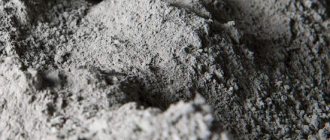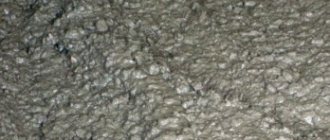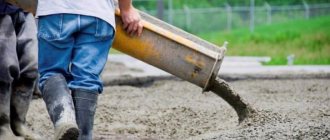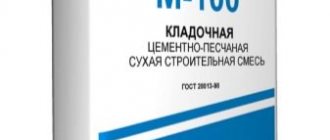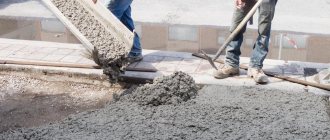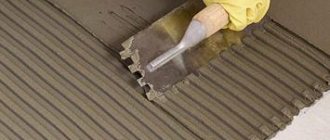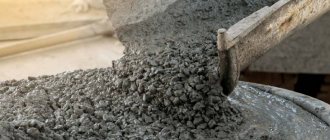Cement-sand mortar is a repair and construction mixture, which includes sand, cement and water, taken in certain proportions, depending on the scope of application and requirements for the material. The solution can be used for pouring floor screed, performing plastering or masonry work. Concrete is also relevant for general construction work.
The exact ratio of ingredients determines strength, density, resistance to various influences and is always selected individually. The composition can be either simple (sand and cement mixed with water) or multicomponent (with the addition of various plasticizers and additives that change certain characteristics of the mixture).
Cement is not used in its pure form, because after mixing and hardening it becomes extremely brittle. As a rule, a sand-cement or lime composition is prepared for brickwork; for plastering walls, a solution with a large volume of cement and fine sand is used; the floor screed is made of a durable material of the appropriate grade.
Peculiarities
High-quality mixtures based on sand and cement will always be relevant. They are distinguished by increased strength and reliability characteristics, the ability to obtain a solution with the desired properties, subject to the correct selection of proportions and high-quality components.
The main components of the mixture are sand and cement, mixed in the volumes established by GOST and supplemented with certain additives. The cement-sand mortar composition can be used for interior/exterior work. Before preparing the mixture, you need to study its features.
The main advantages of cement-sand mortar:
- Possibility to choose a building material with characteristics that exactly meet the requirements, among the variety of mixtures on the market.
- Resistance to sudden temperature changes, heat and frost.
- Easy and simple to prepare and use - just add water to the solution (taking the volume specified in the instructions) and mix thoroughly.
- Excellent strength and reliability indicators, long service life.
- Resistance to moisture.
- Increased adhesion to any other materials - DSP can be used when finishing blocks of various types, stone, brick, concrete, etc.
Among the disadvantages of cement-sand mortars prepared on the basis of factory-produced dry mixtures, it is worth highlighting the following: relatively high cost, the need to quickly use after mixing with water, the importance of correct mixing according to the instructions with the exact selection of components, the difficulty of working with viscous and fairly heavy compositions.
It is also worth remembering that rather poor adhesion has been observed with wooden substrates and coated with paints and varnishes. DSP does not interact very well with gypsum - a very heavy and dense layer of concrete can tear off or deform the base.
As you can see, all these disadvantages are associated with the need to carry out all work according to the rules and instructions, but otherwise there are no obvious disadvantages to cement-sand mixtures.
Adhesion of cement mortars
Despite the good adhesion of cement to mineral bases, in recent years deep penetration soils and the so-called “concrete contact” have been actively promoted in the construction markets. In fact, the benefit from them tends to zero.
Deep penetration primers are useless and even harmful for the reason that they can completely clog the pores in poorly absorbent substrates (for example, smooth concrete). And the porosity of the base is needed for good fixation of the mass of the solution: the particles penetrate into the pores and cling the main layer to the base. With high water absorption, the base is well moistened - this solves the problem of rapid drying.
“Concrete contact” may cause some doubts - it creates a rough surface, while it itself adheres well to smooth concrete. This begs the question - it will be of some use! In fact, not all types of “concrete contacts” are able to withstand the alkaline environment of cement compositions - they simply dissolve in them. Moreover, cement itself has sufficient adhesion to smooth concrete; the main thing is to create favorable conditions for this.
There are two main methods for improving the adhesion of cement mortars to mineral bases: adhesion layer
and
spray
.
The adhesion layer is a more liquid, thin layer of the same solution that is applied to the base. The liquid mixture penetrates well into the pores of the base and provides good adhesion to the base layer. The main layer is laid on top of the non-set adhesive layer to form a single monolith. This technique is more suitable for horizontal surfaces, when the main mass is located on top. On vertical surfaces there is a high probability of swimming, although it all depends on the specific situation.
An example of using an adhesive layer is laying a semi-dry screed without separation from the base. The semi-dry mixture of the base layer is laid on a liquid layer of 1-3 mm, thus the too dry mixture has the opportunity to “stick” to the base.
Spraying is used for plastering - a liquid solution is sprayed onto a moistened base using a broom or brush, forming many protruding lumps. Due to its liquid consistency, the mixture penetrates well into the pores and has excellent adhesion to the base. The difference from the adhesion layer is that the base layer is applied after the spray has set.
A more modern version of the spray and adhesive layer is tile adhesive applied to the base with a comb trowel. Thanks to chemical additives, tile adhesive has slightly greater adhesion and is more convenient to work with. Accordingly, the adhesive layer involves applying the bulk immediately after applying the glue; in the analogy with spraying, you need to wait until the glue sets. When working with spraying, you need to remember that the brand strength of the applied base layer should be less than that of the glue.
To achieve a good result, it is also recommended to make notches on smooth substrates with an ax - this option can be used in conjunction with the ones described above.
To form an adhesive layer and spray, you can use improving additives - PVA glue will improve their characteristics. There are also ready-made additives for these purposes, for example Ceresit CC 81.
Specifications
The properties, parameters and characteristics that a cement mortar must have are defined in GOST. They should be studied before making calculations and performing certain types of work.
Density
This parameter largely affects the strength and thermal conductivity of the hardened cement-sand layer. If you do not add any special additives or plasticizers, the solution turns out to be quite dense and heavy. Thus, in the solid state, the density ranges from 1600 to 1800 kg/m3.
Due to this density and good strength, DSP can be used both for interior/exterior finishing and for pouring floor screed.
Thermal conductivity properties
High density determines a fairly high thermal conductivity. In a room where interior or exterior finishing is done using a cement-sand mixture, heat is well stored. Neither gypsum nor other lighter and more porous materials give such an effect.
The thermal conductivity coefficient of the DSP is 0.3 W. But non-shrink plaster with a similar base demonstrates a level of thermal conductivity within 0.9 W.
Vapor permeability
When finishing, it is very important to take this parameter into account. If layers of materials do not allow air to pass through, condensation may accumulate in the room, becoming an excellent breeding ground for fungi, mold, and other microorganisms. The cement mortar gives a vapor permeability of 0.09 mg/mchPa, which is quite good.
Setting time
The setting speed of mixtures based on cement and sand ranges from an hour to an hour and a half. But here a lot depends on the volume of water in the solution and the introduction of special additives into the composition, which can change the time towards decreasing/increasing. Masters advise preparing the mixture in small portions in order to have time to use it, since after the hydration process begins, the material becomes unsuitable for pouring, masonry, or plastering, losing strength.
Calculation of the required quantity
Before starting the preparation of cement-sand mortar, it is necessary to select the correct ratio of materials and determine the consumption. But before this, the required volume of cement mixture is determined in order to calculate the materials. The description usually indicates the consumption of the finished DSP based on consumption per square meter based on a layer one centimeter thick. To obtain the material costs per cubic meter, you simply need to multiply this value by 100.
Mixture consumption:
- High grade compositions - about 2200 kilograms per cubic meter.
- Light plasters with the addition of lime - from 1200 to 1600 kg/m3.
To determine the consumption of the mixture for screed or plaster composition, everything is simple: calculate the total area of the wall or floor, then you need to multiply by the thickness of the layer (in centimeters) and calculate the required volume of solution. But as for the consumption of material for masonry, much depends on the experience of the master. According to the technology, the consumption of DSP is about 25% of the volume of the wall, but the indicator is affected by the amount of splashes and the thickness of the seams.
Drying time
This parameter depends on the thickness of the DSP layer and the ambient temperature. So, at temperatures ranging from +15 to +25 degrees, a layer of 2 centimeters will dry within 12-14 hours. If the layer is thicker, then the drying time increases.
Craftsmen advise not to perform any manipulations with the surface for a day or two after completing the work (or even more if the layer is large).
Component consumption
In order to prepare cement-sand cement of the required strength and properties, the proportion on which the consumption of components depends must be strictly observed. The standard (accepted in the standards) ratio of cement and sand in cement fiber cement is 1:3 with a W/C of 0.45-0.55, subject to the choice of binder grade M400.
Main components for DSP:
- Cement acts as a binder, usually M400 or M500 is used, with a production date less than 6 months ago. The fresher the cement, the more active it is and the better the characteristics the mixture will give.
- Sand – with dense coarse grains, without impurities of dust and clay. The sand must be clean - this is important, otherwise it needs to be washed and dried.
- Pure water – without impurities, temperature about +20C.
Depending on the scope and characteristics of the application, the ratio of components in the solution may be different. It all depends on the chosen brand.
Selecting a cement-sand mixture for its intended purpose:
- For masonry
– they use grades from M50 to M200; when working with load-bearing structures, you need to use a solution of at least M100; installation of a prefabricated foundation requires the strength of grade M200 at least. In this case, the proportion of cement and sand is 1:2.
- Plaster
– mixtures from M10 to M50 are relevant, necessarily plastic, which is achieved by introducing clay, lime paste, gypsum and other components into the composition.
- Filling the screed
– from M150 and above. When mixing such a solution, it is important to correctly determine the W/C (about 0.45-0.55), since excess water can cause cracks. The proportions are classic: 1:3 or 1:2.8, cement grade minimum M400.
What is sand concrete made of?
The characteristics of sand concrete m300 (composition, proportions 1 m³) are standardized by GOST 7473-94.
High-quality dry mixture contains:
- Portland cement PC500 D20/PTs400 D0;
- fractionated dry sand, with a combined composition of fractions (particle size 0.80-4.0 mm);
- other additives (frost-resistant, microsilica, fiberglass) are introduced at the discretion of the manufacturer.
Sand concrete M300 can be used to construct wear-resistant, high-strength floors as a load-bearing covering in utility and residential premises, including garages, basements (with a load of 250-300 kg/cm²)
Depending on the sand used, M300 grade material is used to carry out certain work:
| Sand, particle size, mm | Characteristic | Application |
| Small – 0.80-1.20 | High wear resistance and strength characteristics | Carrying out critical masonry and other external work, light floor screed 50.0 mm, installation solutions of increased strength |
| Average – 1.80-2.20 | Increased resistance to operating loads | Implementation of interior work, laying curbs, paving slabs, erection of Euro fences, screed up to 100 mm, “warm floor” systems |
| Large – 2.50-4.0 | Moderate moisture absorption | Construction of slab, strip and column foundations, plinths, pit floors, without restrictions on thickness using reinforcement |
Varieties
There are many mixtures with a cement-sand base. All of them are presented in specialized stores and have their own characteristics.
M100
The composition is most often chosen for mixing plaster, since it contains lime and a reduced proportion of cement. The cost of the dry mixture is small, it can be used both for plastering walls inside and outside, and for leveling various surfaces, eliminating defects (lumps, cracks, potholes, drops, crevices, etc.).
M150
This is a universal DSP, which is suitable for mixing masonry and plaster mortars. You can also make a screed from the mixture and use it in repair work. This mixture can be used to replace a variety of compounds in everyday life; additives can be added for strength and durability. The cost of the mixture is affordable.
What is the difference between the cement-sand mixture M150:
- Consumption per 1m2 is 16.5 kilograms
- The optimal layer thickness is 5-50 millimeters
- Setting time – 2 hours, complete hardening occurs within 24 hours
Ready-made masonry mortars M150 are available for sale. When purchasing, be sure to pay attention to the presence and type of additives in the composition.
M200
This is an installation and masonry mortar that may have a different composition. There are several types of mixtures: for masonry, plaster, foundation/screed. The solution layer turns out to be reliable and dense; the consumption for a layer thickness of 5 millimeters is about 7.5-8.5 1 m2.
M300
The most popular mixture, which is also called sand concrete or foundation composition. The cost is higher than that of mixtures of a lower grade; the scope of application is quite limited: the mixture provides increased strength, which is relevant when performing not all types of work.
This solution is best used for making massive screeds and installing serious mounting structures. Dry composition is not suitable for plaster.
General information
A characteristic feature of concrete is its composition, as well as proportions and preparation technology. It consists of cement, fine and coarse fillers, water and various additives. In addition, there are brands of concrete that do not contain coarse filler. There are different mixtures that are used for specific cases and also have different properties.
Designation and its interpretation
Concrete structures gain full strength within 6 months, and in 30 days concrete gains 70% strength. M300 is used in all structures that are subject to significant load, therefore, one of the main indicators is its strength. The MXXX designation template does not indicate a specific brand, but is an indicator of the maximum compression pressure.
In addition, there are other designation patterns, for example, FXXX and WXXX, indicating frost resistance and water resistance, respectively. The M300 class of concrete shows the totality of all grades whose ultimate strength is 300 kgf/sq.m. cm. The tensile strength is tested in laboratory conditions by applying force to parallel planes of a product cast from concrete, in the shape of a cube with a side of 150 mm. The grade of concrete in terms of strength is correlated with its class. These indicators should be selected for the construction and calculation of the finished structure at the maximum load that it can withstand.
M300 corresponds to class B22.5 with a coefficient of variation (CV) that is 13.5%. It shows the homogeneity of the mixture from which any brand of concrete is made. When this coefficient changes, the grade of concrete will also change, that is, if its value is low, the grade will increase and vice versa. If the concrete is M300, then with different values of the coefficient its class will change:
- At Kv = 5% the class is B25.
- At Kv = 13.5% - B22.5.
- At Kv = 18% - B15.
Main characteristics
Concrete is classified into grades, and this distribution is primarily related to the parameters of strength (B), density (D), water resistance (W), frost resistance (F) and workability (P). One of the best options for most construction work is M300 concrete, the characteristics of which are as follows:
- Strength: B22.5 with an indicator of 295 kg/sq. cm.
- Specific gravity of concrete M300: 1800−2500 kg/cubic. m.
- Water resistance: W6-W8.
- Frost resistance: F200-F300.
- Mobility: P2-P4.
The strength indicator is the main characteristic and shows the maximum effect of forces during compression, at which the structure collapses. The specific gravity or density of M300 concrete depends on the type of coarse filler included in its composition. When using limestone, the D value is about 1800 kg/m3. m., and when using harder rocks (crushed granite, granodirite, etc.) it can reach a value of 2500 kg/cubic. m. Due to its high density, this type is classified as heavy. The density indicator depends on the presence of violations in the manufacturing technology and air cavities.
Water resistance (WXX) is a value indicating the water pressure in MPa to pass through 0.15 m of concrete. For concrete grade M300, this indicator is equal to W5-W6; at a pressure of 0.5-0.6 MPa (approximately corresponding to 5-6 atmospheres) it does not allow water to pass through at all. By adding hydrophobic cement, additives and carefully compacting the solution, it is possible to increase the waterproof rating.
Frost resistance is indicated in the form of the FXXX pattern and shows the number of defrost-freeze cycles without loss of strength. This characteristic can be increased in several ways:
- The use of additives that prevent the formation of air bubbles.
- Removing air from the concrete mixture using vibrators, as well as using various compactors.
- Reducing the amount of water (impairs mobility).
- Using solid fillers instead of crushed limestone.
Application in construction
Since M300 has good strength, frost resistance, water resistance and mobility, it is widely used in construction. In addition, its main indicators can be adjusted by changing the components included in the concrete mixture. It is advisable to use it for the following work:
- Construction of platforms, roads and curbs.
- Installation of walls and various supports.
- Construction of stairs, landings and pouring of foundations in multi-storey buildings.
- Production of reinforced concrete products and fences.
- Production of sewer pipes that are constantly exposed to moisture.
- Construction of objects that are affected by constant temperature changes.
Scope of application
Cement-sand mixtures are very popular today and are used everywhere.
Where and how are DSPs used:
- Interior decoration - add a little cement to the mixture, add lime, select fine and homogeneous sand.
- Universal compositions - suitable for masonry, facade/interior work, screeds. The mass of cement in the solution is standard, often containing plasticizers.
- Masonry - for the construction of mid-rise buildings made of brick.
- Floor screed - rough or finishing, protruding and the main coating.
- Facade finishing work - there is more cement here, hydrophobic additives have been added, as well as substances to increase frost resistance and reduce shrinkage.
- Construction of multi-storey buildings - mixtures M400-M600 are used, they contain a lot of cement, reinforcing fiber, and special additives.
- Leveling walls/floors – eliminating various defects for finishing.
Pouring concrete 200 - recommendations from professionals
Professional builders suggest concreting in compliance with the following recommendations:
- place the reservoir with the solution in close proximity to the work site;
In order for it to have the highest characteristics and greater strength, various additives are added to the mixture during its manufacture.
- pour from a height of no more than one meter to prevent delamination;
- use a chute to supply the mixture, which allows you to more accurately distribute the solution;
- prepare the concrete solution at a temperature of more than five degrees Celsius;
- concrete in one go, allowing breaks of no more than 2 hours;
- compact the array, especially in the locations of the reinforcement cage;
- Moisten the surface periodically.
Compliance with these rules will avoid cracks and ensure the quality of the monolith.
Tools for work
To make a solution, you need to have everything you need on hand and preferably prepare the tools in advance, so that later you don’t have to waste time searching or pouring out the components “by eye” for lack of containers, etc.
What you need to work with cement-sand mixture:
- Mixing container - a pallet or concrete mixer, a large rectangular bowl (trough). It is best to choose a concrete mixer, since the pallet is difficult to work with, and individual components can collect in a container with corners.
- Shovel - for laying components.
- Bucket - used as a measuring container when determining the volume of components.
- A construction mixer or drill for mixing the composition (if you are preparing a little).
- Construction cone - can be useful for determining the level of mobility of the mixture.
- Tools for performing work - rules, trowels, spatulas, etc., the set depends on the task.
Moisture resistance and water resistance of cement
Sometimes you hear the expression “moisture-resistant cement” or “moisture-resistant tile adhesive” - this only shows the speaker’s illiteracy. I propose to look into this issue. First, let's understand the terms.
Moisture resistance
building material is the ability to withstand prolonged exposure to moisture with periodic drying without destruction or softening. In simple words, the material can periodically get wet and dry without collapsing or losing its properties.
Water resistance
- this is the ability to not be destroyed under the influence of water for a long time. In other words, water can constantly stand on the material without compromising its strength.
As we already learned above, cement is a hydraulic binder and it only becomes stronger with water. Therefore, the cement itself is moisture-resistant and waterproof by default. Here you need to first evaluate the properties of the filler - sand, lime mortar and other materials. Of course, if sand is used as a filler, then the mixture is also moisture-resistant and waterproof. Lime mortar is susceptible to rotting when exposed to moisture for a long time, so it cannot be called waterproof, but perhaps moisture resistant.
In general, if the solution contains non-moisture-resistant and water-resistant components, then the finished solution cannot be called such.
Cement-sand mixtures have absolute water resistance, please do not confuse them with water permeability - although water does not harm cement stone, it passes through it with ease. Therefore, if there is material susceptible to moisture under the solution, it must be protected.
Cement is also afraid of moisture when exposed to negative temperatures - water, freezing, expands and destroys micropores year after year. In such cases, the water absorption of the material is greatly influenced - with semi-dry manufacturing technologies, the water absorption is much lower.
How to cook
You can make a sand-cement mixture yourself or buy ready-made dry powder. The second option is more expensive, so craftsmen often choose the first. In this case, you need to correctly determine the weight and volume of the components, quickly mix the solution and use it for its intended purpose.
For screed
Cement grade M400 or M500 is mixed in a ratio of 1:2 or 1:3, respectively. To eliminate the risk of cracks and other deformations on the surface, fiber fiber is introduced into the mixture at the rate of 0.7-0.9 kilograms per cubic meter of solution.
For masonry
The most important component here is sand, which must be sifted and dried, fine and clean. To one part of cement take 3-5 parts of sand. The solution is prepared in portions, the first portion is checked on a separate surface for quality, then the ratio is adjusted if necessary.
For plaster
The components are mixed in a standard ratio of one to three (cement and sand). The strength and quality of the solution depend not only on the composition, but also on the thoroughness of mixing.
It is very difficult to achieve the desired effect by kneading by hand; it is better to use a concrete mixer or an electric drill, or a hammer drill with special attachments.
Composition of sand concrete m200
The composition of sand concrete is determined by GOST 31357 - 2007 “Dry mixtures for construction with a cement binder”. Each manufacturer can make small additions to the composition of the mixture, but there are key components and indicators that are standard.
Main components:
- Cement m400;
- Sand;
- Crushed stone;
- Water.
When creating, Portland cement M400 is mainly used; it is one of the most common, and its technical characteristics meet all specified standards. Sand is used in two types of fractions - fine-grained and coarse-grained, thoroughly cleaned of foreign impurities.
The composition and proportions of sand concrete m200 per 1m3 according to construction standards, the mixture consumption is:
- Portland cement - 265 (1 part);
- sand 860 (2 parts);
- crushed stone 1050 (5 parts);
- water 180 (? parts).
Supplements
The number and variety of substances that are introduced into the composition of CPS in certain volumes is quite large today. It is sometimes difficult to choose what you need among them without first understanding the features and properties of the additives.
What is added to the DSP and why:
- PVA glue – provides additional adhesion, plasticity, and comfort in working with the solution. Often added to plastering mixtures.
- Slaked lime - this component needs water, in accordance with the volume of which a certain mass of lime is added (lime water or fluff). Extinguishing is carried out several weeks before the implementation of repair work.
- Soot and graphite give the solution a certain color.
- Liquid soap and dishwashing detergent - the finishing material acquires increased plasticity. These components are added to the composition immediately after water, usually 50-100 milliliters is enough. If you add more product, soap bubbles will make it difficult to work with the mixture and the strength will decrease.
*Explanations for the calculator
- The calculator can calculate the volume for both whole numbers and fractions. Example: volume of concrete 3m 3, volume of concrete 50 l (0.05 m 3).
- The calculator implements calculations for a mixture with mobility P3 (9-10 cm of cone slump) for cement-lime mortars (according to SP82-101-98). Water consumption for mixtures with different mobility is based on experimental batches. The mobility you need can be viewed in the “Mobility” field, which is automatically filled in when you select “Solution purpose”.
Manufacturers
The modern building materials market offers a fairly large selection of various mixtures and powders for various tasks. It is worth choosing products from trusted manufacturers who guarantee high quality components and their creation in accordance with technology.
"Monolith"
A large manufacturer that creates and sells cement-sand mixtures at a plant in Kirov. The range is quite large, it includes reliable and high-quality compositions of the M150 brand, well suited for plastering, sealing joints, and masonry indoors and outdoors.
We also sell reliable compositions of the M300 brand, which are relevant for the production of high-strength concrete structures.
Knauf
A well-known brand that supplies the market with high-quality cement and plaster mixtures in several lines (Sivener, Adhesive, Grünband, Unterputz). All products have excellent thermal insulation properties. Suitable for completing a full range of finishing works - interior/exterior. In most of the manufacturer’s mixtures, components are added to the composition to enhance positive properties.
"Real"
The manufacturer's products are popular and supply high-quality cement mixtures of the M75 and M150, M100 and M200 brands. The range allows you to choose what you need for finishing and repair work. Most dry mixes are supplemented with components to increase frost resistance, which expands the possibilities of working with them and allows them to be used both inside and outside.
Dauer
A German brand that offers inexpensive, high-quality DSP for finishing facades and walls indoors, pouring screeds, installing blocks and bricks.
The manufacturer's dry mixtures are very popular because they have low consumption and an affordable price, which, in general, can significantly reduce the cost of work.
"BaltPiterStroy"
A large Russian company supplying the market with cement-sand mortars of all brands. Also among the products you can find other components - rubble, gravel, crushed stone, sand, cement in bags and various reagents (anti-icing, for example).
"Stroyservis-Novablock"
Previously, the manufacturer’s cement-sand compositions were presented on the market under the Plita Milks brand. In addition to dry mixes, the product range includes a high-strength sand and gravel mixture of the M300 brand. All compositions are of very good quality, as they are produced on modern factory equipment on an industrial scale.
"Adamant SPB"
The plant offers a huge range of crushed stone, sand, cement, reinforced concrete products, and high-quality concrete. DSPs are represented by a variety of brands - the line includes both M100 and M400.
Expert advice
In the process of preparing a cement-sand mixture, the mass and quality of materials, compliance with the optimal ratio of components, correct preparation of the solution and mixing technology are of great importance. To avoid common mistakes, you should use the experience of professionals.
Current advice from the experts:
- When leveling walls using DSP, it is imperative to install beacons, without which the work will be of poor quality and labor-intensive.
- When choosing cement, you need to look at the date of manufacture - the material is stored for a maximum of 6 months. The less time has passed since production, the better. Cement can be stored in a dry room, on special pallets.
- After mixing, the solution is used for a maximum of two hours. Then the mixture dries, the hydration process begins, and even if it is possible to use the material, the result will be of poor quality.
- When adding water to the composition, you need to carefully monitor the volume - excess may not affect the quality of the solution.
- For finishing wooden and gypsum bases, simple cement-sand compositions are not suitable; clay mixtures with a small percentage of cement are needed. This material can be used to decorate internal/external surfaces.
- The weight of the DSP is quite large, which negatively manifests itself on an unreliable and weak foundation: the material quickly falls off, becomes covered with cracks and defects.
- All containers and tools used in the work are washed immediately after everything is done. After all, once the cement mixture has hardened, it will be impossible to remove it from the surface.
- When preparing a mortar for the foundation, it is best to mix the composition of the M300 brand, since cheaper and simpler mixtures will not provide the required strength.
- To extend the drying time of the mixture, you need to add a little less cement or sand to it. If there is more sand or cement than the ratio, the material will become completely unsuitable for use.
- It is best to prepare the solution in a plastic or metal container.
- River sand is not used for the cement-sand mixture; it is usually taken from the ground.
- The solution should not be very liquid - then it does not fit well on the base and slides off the tools.
When preparing a cement-sand mixture, special attention must be paid to the quality of the components and their ratio. A correctly prepared solution that complies with GOST will make it possible to perform various types of work, guaranteeing the strength, reliability and durability of the finish.
Working time and setting
The “lifetime” of a solution refers to the period allotted after mixing for application and leveling. In other words, how long can the finished solution be used without compromising quality?
In the current GOST 30515-2013, there is the concept of the beginning of setting - if we discard unnecessary details, this is the very time during which all manipulations with the introduced solution must be done. The same regulatory document states when setting should begin for normal-setting cements: from 45 minutes. up to 2 hours
This does not mean that the solution cannot be used after more than 45 minutes - it is quite possible, but it should be understood that its strength will decrease. More important in my opinion is the fact that applied after 45 minutes. the second layer will no longer become one with the previous layer
- this must be remembered. In other words, when forming a single, monolithic layer, you should not take breaks for more than 40 minutes, or even better, do without breaks at all.
